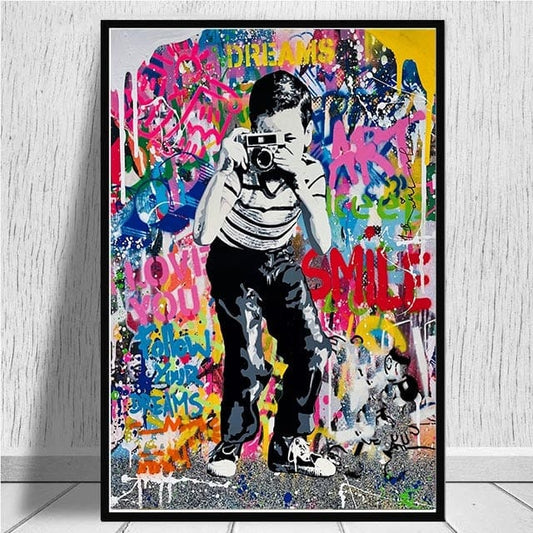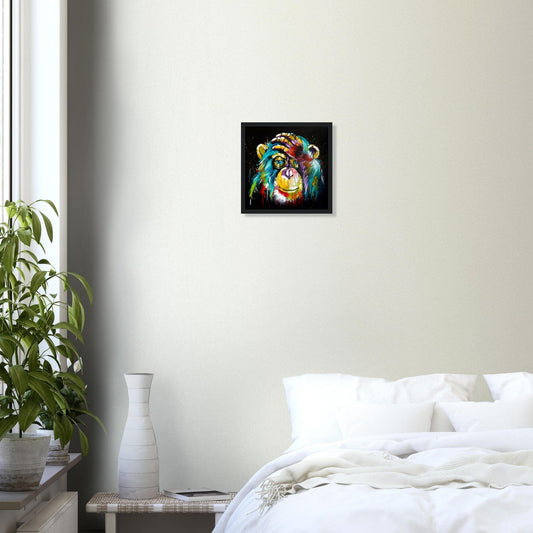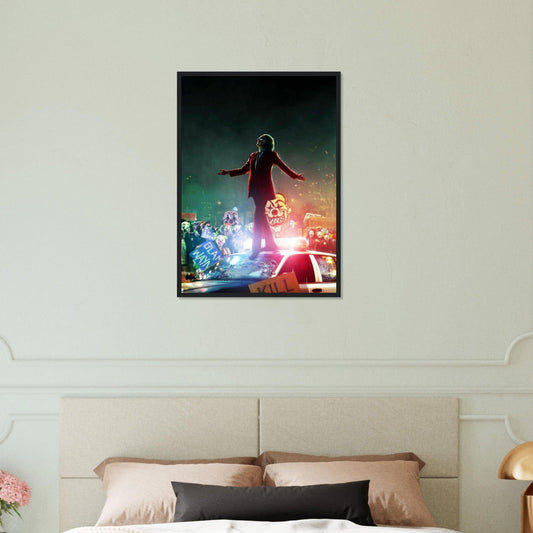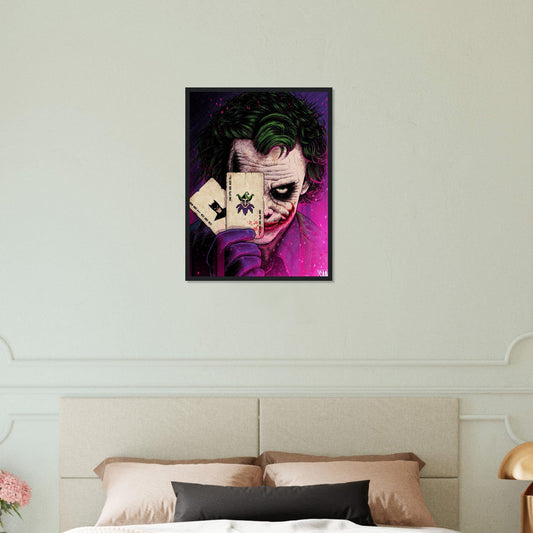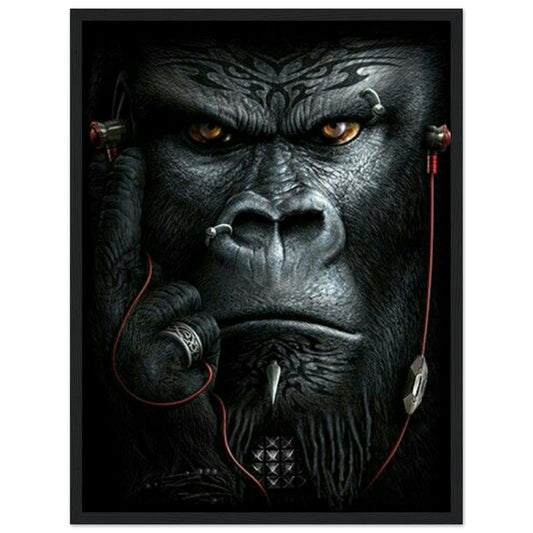-
Painting Street Art Style Hand
5.0 / 5.0
(15) 15 total reviews
Regular price From €13,56 EURRegular price€27,12 EURSale price From €13,56 EURSale -
Banksy Paintings Street Art
5.0 / 5.0
(5) 5 total reviews
Regular price From €48,24 EURRegular price€96,48 EURSale price From €48,24 EURSale -
Banksy Street Art Canvas
5.0 / 5.0
(5) 5 total reviews
Regular price From €48,24 EURRegular price€96,48 EURSale price From €48,24 EURSale -
Frame 3 Monkeys Listen Silence See
5.0 / 5.0
(13) 13 total reviews
Regular price From €96,62 EURRegular price€125,61 EURSale price From €96,62 EURSale -
Pop Art Monkey Painting
5.0 / 5.0
(11) 11 total reviews
Regular price From €55,99 EURRegular price€67,19 EURSale price From €55,99 EURSale -
 Sold out
Sold outPainting Street Art Graffiti Kiss
5.0 / 5.0
(15) 15 total reviews
Regular price From €31,99 EURRegular price€63,98 EURSale price From €31,99 EURSold out -
Street Art Graffiti Painting
5.0 / 5.0
(1) 1 total reviews
Regular price From €48,32 EURRegular price€96,64 EURSale price From €48,32 EURSale -
Luxury Pop Art Painting Boxing Gloves
Regular price From €8,99 EURRegular price€17,98 EURSale price From €8,99 EURSale -
“Eat, Sleep, Play, Repeat” Painting for Gamers
5.0 / 5.0
(15) 15 total reviews
Regular price From €28,55 EURRegular price€57,10 EURSale price From €28,55 EURSale -
Joker Pop Art Painting
Regular price From €104,86 EURRegular price€125,83 EURSale price From €104,86 EURSale -
Pop Art Joker Painting
Regular price From €104,86 EURRegular price€125,83 EURSale price From €104,86 EURSale -
Pop Art Joker Painting
Regular price From €104,86 EURRegular price€125,83 EURSale price From €104,86 EURSale -
Joker Pop Art Batman Painting
Regular price From €104,86 EURRegular price€125,83 EURSale price From €104,86 EURSale -
Simpson Football Painting
Regular price From €71,99 EURRegular price€86,39 EURSale price From €71,99 EURSale -
Pop Art Gorilla Painting
Regular price From €104,86 EURRegular price€125,83 EURSale price From €104,86 EURSale -
Pop Art Tiger Painting
Regular price From €104,86 EURRegular price€125,83 EURSale price From €104,86 EURSale
Collection: Pop Art Paintings
Pop art is an artistic movement that emerged in the 1950s and revolutionized the way we perceive art. This bold and deliberately popular form of visual expression has taken the art world by storm with its vibrant color palette and familiar subjects. In this article, we will explore the fascinating world of pop art through seven captivating subtitles.
Pop Art: What is it?
Pop art, short for popular art, is an artistic movement that has its roots in popular culture and mass consumption. It celebrates pop culture objects and icons, such as comic books, consumer products, celebrities and advertising. Pop artists seek to capture the essence of pop culture and transform it into a work of art.
1. Origins of Pop Art
Pop Art emerged as a reaction to Abstract Expressionism, which emphasized emotions and abstraction. Pop Art artists sought to shift the center of gravity of art from abstraction to everyday reality. They were influenced by the rise of consumer culture, mass media and advertising. The 1950s and 1960s were marked by economic prosperity and the spread of popular culture.
2. Pop Art Subjects
Pop Art celebrates objects and icons of popular culture. This includes things like comic books, consumer products, celebrities, logos, advertisements, and everyday objects. Pop Art artists took familiar elements of mass culture and transformed them into works of art. They used these topics to explore themes of banality, repetition and mass consumption.
3. Pop Art Techniques
Pop Art introduced new artistic techniques that contributed to its distinctive aesthetic. Screen printing, for example, was a popular technique that allowed artists to quickly and efficiently reproduce an image repeatedly. Stencil painting, bright colors and graphic designs were commonly used to create a strong visual impact.
4. Main Pop Art Artists
Pop Art saw the emergence of emblematic artists, whose works became symbols of the movement. Among them, Andy Warhol is undoubtedly the most famous, with his portraits of celebrities and his cans of Campbell's soup. Roy Lichtenstein is another popular artist, known for his comic book-inspired paintings. Other notable artists include Claes Oldenburg, Jasper Johns and Robert Rauschenberg.
5. Cultural Impact
Pop Art has had a significant cultural impact. He has transcended the boundaries of art and influenced fashion, design, music, advertising and society in general. Pop art works have become iconic, and some of them are still widely recognizable today.
6. Evolution and Legacy
Over the years, Pop Art has evolved to reflect social and cultural changes. Although the original movement emerged in the 1950s and 1960s, contemporary artists continue to draw on its principles and adapt them to more contemporary themes. The legacy of Pop Art endures, and its principles of celebrating popular culture are still relevant.
The Evolution of Pop Art
Over the years, pop art has evolved to reflect social and cultural changes. While it began by celebrating American popular culture of the 1950s and 1960s, it continued to evolve over time. Contemporary artists have adapted pop art to explore more contemporary themes, such as consumer society and globalization.
The Evolution of Pop Art: From Past to Present
Pop Art, which emerged in the 1950s and 1960s, was a revolutionary art movement that redefined the way we perceive art. Over the decades, Pop Art has evolved to reflect social and cultural changes. In this article, we will explore the fascinating evolution of this artistic movement through different stages of its history.
The Early Days of Pop Art
Pop Art began in a period of economic prosperity and mass consumption. Artists of this era sought to capture the essence of popular culture, using familiar subjects such as consumer products, celebrities, and advertising. The iconic works of Andy Warhol and Roy Lichtenstein marked the beginning of this artistic revolution.
The 1970s: Broadening Horizons
During the 1970s, Pop Art began to evolve. Artists explored new themes, going beyond just celebrating pop culture. They addressed deeper issues, such as politics, consumer society and globalization. Works from this period often reflect a more critical view of mass culture.
Pop Art in the 1980s: Postmodernism
The 1980s were marked by postmodernism, a movement that challenged traditional notions of art. Pop Art continued to influence the art scene of this decade, with artists like Keith Haring and Jean-Michel Basquiat incorporating pop elements into their work, while exploring new forms of artistic expression.
Contemporary Pop Art
Contemporary Pop Art has seen a reinterpretation of the movement to reflect the concerns and themes of the times. Today's artists continue to use elements of popular culture, but they integrate them into a more contemporary context. They cover topics such as technology, social media and gender issues.
The Internationalization of Pop Art
While Pop Art emerged primarily in the United States and the United Kingdom, it quickly became international. Artists around the world have adopted the principles of Pop Art to express their own artistic vision, often adapting the movement to the specifics of their culture.
The Enduring Cultural Impact
Pop Art continues to have a significant cultural impact. His works can be found in art galleries around the world, and the influence of Pop Art can still be seen in fashion, design, advertising and music. The elements of Pop Art have left an indelible mark on contemporary culture.
The Enduring Legacy of Pop Art
In conclusion, Pop Art is an artistic movement that evolved to reflect social, cultural and artistic changes. From its beginnings in celebrating popular culture to its current role in contemporary artistic expression, Pop Art continues to inspire and influence artists around the world. His enduring legacy is proof of his continued relevance in the art world.
Pop Art Techniques
Pop artists have often used daring techniques to create their works. Screen printing, stenciling, and the juxtaposition of bright colors were key elements in creating the distinctive aesthetic of pop art. These techniques allowed artists to mass-produce works, thereby strengthening the connection between art and mass culture.
Pop Art Techniques: The Magic Behind the Brilliant Colors
Pop Art is not only famous for its iconic subjects and celebration of popular culture, but also for the innovative artistic techniques that brought its works to life. In this article, we'll dive into the specific methods Pop Art artists used to create iconic works of art.
1. Screen Printing: Repetition of Images
Screen printing is one of the most emblematic techniques of Pop Art. It consists of printing an image using a stencil or a screen, allowing the same image to be reproduced several times. This technique has been widely used by artists such as Andy Warhol to create series of identical artworks. Screen printing allowed Pop Art artists to play with repetition, banality and mass consumption.
2. Stencil Painting: Bright Shapes and Colors
Stencil painting is a technique that involves using stencils to create shapes and patterns on a canvas. Pop Art artists often used stencils to add graphic elements and geometric patterns to their works. This contributed to the movement's distinctive aesthetic, characterized by bright colors and bold compositions.
3. The Juxtaposition of Bright Colors: Brightness and Contrast
Pop Art is famous for its bold use of bright colors. Artists in this movement often juxtaposed bright, contrasting colors to create a strong visual impact. Bright colors were used to draw attention to familiar topics in popular culture and to evoke an emotional response in the viewer.
4. The Appropriation of Pre-Existing Images: Reinventing Pop Culture
Many Pop Art artists used pre-existing images, such as photographs of celebrities, comic books or advertisements, as the basis for their works. They often transformed these images into works of art by reinterpreting or modifying them in creative ways. This technique of image reappropriation helped explore themes of celebrity, mass consumption and repetition.
5. Use of Photography and Overlay
Pop Art artists frequently incorporated elements of photography into their works. They used photographic images to capture celebrity faces, consumer products, and other iconic subjects from popular culture. By superimposing these photographic images with other artistic elements, they created a dialogue between reality and art.
6. Use of Texts and Words
Pop Art artists also incorporated words and texts into their works. These textual elements were often used to add a conceptual dimension to the works or to reinforce the message behind the image. The words and slogans enhanced the visual impact of the work and helped communicate the artist's message.
The Cultural Impact of Pop Art
Pop art has had a significant impact on popular culture and contemporary art. He has influenced many fields, from fashion to design to music. Elements of pop art continue to inspire artists around the world, and its iconic works remain essential symbols of pop culture.
1. Democratization of Art
One of the most revolutionary aspects of Pop Art was the democratization of art. Unlike traditional art, often perceived as elitist, Pop Art appropriated objects and images from everyday life to transform them into works of art accessible to all. This helped make art more inclusive and broaden its audience, as it highlighted subjects familiar to a wide range of people.
2. Reflection on Mass Culture
Pop Art criticized, but also celebrated, mass culture and consumption. By depicting consumer products, advertisements and celebrities, Pop Art artists encouraged the public to think about consumer society and its consequences. This reflection on mass culture has stimulated discussions on contemporary society, advertising, globalization and cultural identity.
3. Celebrity Celebration
Pop Art artists, particularly Andy Warhol, transformed celebrity into an art form in its own right. Warhol, with his repeated portraits of celebrities, elevated figures such as Marilyn Monroe and Elvis Presley to artistic icons. It has helped to redefine how we perceive celebrity, both as a cultural concept and as an artistic subject.
4. Influence in Fashion and Design
Pop Art has left a lasting mark on the world of fashion and design. The geometric patterns, bright colors and graphic elements characteristic of Pop Art have become essential elements of product, clothing and accessory design. Fashion and design creators have regularly borrowed elements from Pop Art to create products that are both elegant and bold.
5. Pop Music and Popular Culture
Pop Art significantly influenced popular music. Album covers, concert posters and music videos have often been influenced by the Pop Art aesthetic. Artists such as The Beatles, David Bowie and Lady Gaga incorporated elements of Pop Art into their image and music, creating a deep connection between pop music and the art movement.
6. The Art of Advertising
Advertising was also deeply influenced by Pop Art. Advertising campaigns adopted graphic elements, bright colors and Pop Art-inspired designs to attract public attention. Pop Art demonstrated the power of advertising to influence culture and society's perception.
Pop Art: An Enduring Legacy
Pop art remains an artistic movement that continues to captivate and inspire future generations. Its lasting legacy is evident in art galleries around the world, as well as in our daily lives, where the influence of pop art remains palpable.
1. Accessibility of Art
One of Pop Art's most significant legacies is its commitment to making art accessible to all. By using everyday objects as subjects, Pop Art broke the traditional barriers that made art elitist. This inspired more people to become interested in art and recognize the beauty in the mundanity of popular culture.
2. Aesthetics Revolution
Pop Art's distinctive aesthetic, characterized by bright colors, geometric shapes and iconic images, has had a profound impact on the world of design, fashion and advertising. Pop Art motifs and techniques are still widely used in product design, advertising campaigns, fashion and interior design.
3. Exploring Celebrity
Pop Art introduced celebrity as an artistic subject. Artists like Andy Warhol have transformed famous figures into cultural icons, sparking reflection on celebrity as a concept and its influence on contemporary society.
4. Influence in Pop Music
Pop music has been deeply influenced by Pop Art. Musical artists have incorporated elements of the movement into their visuals, music videos, and album covers. Pop Art thus contributed to forging close links between pop music and visual culture.
5. Questioning the Artistic Standard
Pop Art challenged traditional norms of art, paving the way for new forms of artistic expression. The movement encouraged artists to explore unconventional mediums, such as screen printing, sculpture in ordinary materials, and photography, while maintaining a conceptual approach to art.
6. The Globalization of Art
Pop Art has transcended geographical boundaries to become a global artistic phenomenon. Artists from around the world have appropriated the principles of Pop Art to express their own artistic visions. This contributed to the internationalization of contemporary art.
7. Inspiring Contemporary Creativity
Pop Art continues to inspire contemporary artists. Its themes of mass culture, repetition, banality and mass consumption remain relevant in today's world. Contemporary artists often integrate elements of Pop Art into their works to address current issues.
In conclusion, Pop Art is much more than just an artistic movement of the past; it is a lasting legacy that continues to influence and inspire contemporary creativity. His artistic revolution, his commitment to the accessibility of art and his exploration of popular culture are all elements that have marked world culture. Pop Art remains a source of inspiration for artists and a window open to contemporary society.




